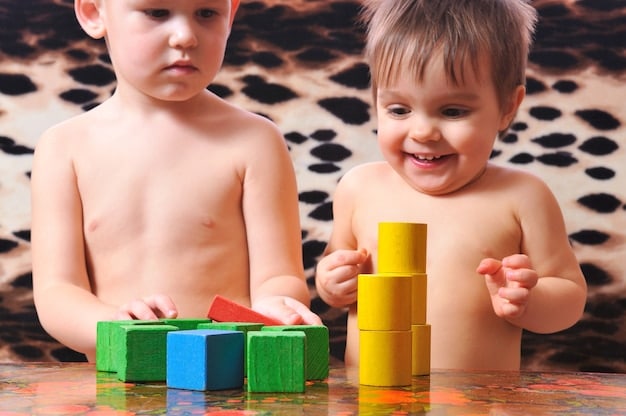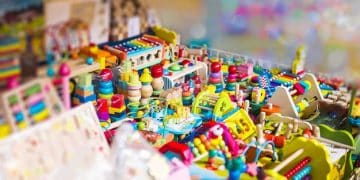Sustainable Toys: Impact on the US Market by 2025

Sustainable toy manufacturing is poised to significantly impact the US toy market by 2025, driving demand for eco-friendly materials, ethical production, and innovative designs that appeal to environmentally conscious consumers and retailers.
The toy industry is undergoing a significant transformation. How will sustainable toy manufacturing impact the US toy market by 2025? This article explores the key trends and changes to expect.
The Rise of Eco-Consciousness in Toy Consumption
Consumers are increasingly aware of the environmental impact of their purchases. This is especially true for parents, who are seeking toys that are not only fun but also safe and sustainable for their children and the planet. This growing eco-consciousness is a major driver of change in the toy market.
This shift in consumer values is pushing manufacturers to rethink their production processes and materials. The impact of this change can be seen through every single company involved in the process.
Consumer Demand for Sustainable Toys
Growing awareness of environmental issues has led to a surge in consumer demand for sustainable and ethically produced toys. Parents are actively seeking alternatives to traditional plastic toys, opting for products made from renewable materials.
The Influence of Social Media
Social media platforms play a significant role in shaping consumer perceptions and driving demand for sustainable products. Influencers and online communities often highlight eco-friendly toy options, further boosting their popularity.
- Increased online searches: Parents are actively searching for terms like “eco-friendly toys” and “sustainable toy brands”.
- Influencer endorsements: Many parenting influencers are promoting sustainable toys on their social media channels, reaching a wide audience.
- Community discussions: Online forums and communities dedicated to eco-conscious living often feature discussions and recommendations for sustainable toys.
The rise of eco-consciousness in toy consumption is not a fleeting trend. It signifies a fundamental shift in consumer values that will continue to shape the toy market in the years to come. This section has given a good overview of the rise of eco consumption and its connection to toys.

Materials Matter: The Shift Towards Sustainable Toy Materials
Traditional toy manufacturing relies heavily on plastics, many of which are derived from fossil fuels and contribute to environmental pollution. The shift towards sustainable toy manufacturing impact the US toy market by 2025, with materials playing a very important role.
Sustainable toy materials refer to those that are sourced responsibly, have a low environmental impact, and are safe for children. These materials are usually sourced from renewable sources.
Wood from Sustainably Managed Forests
Wood is a popular sustainable alternative to plastic. Look for toys made from wood sourced from forests certified by organizations like the Forest Stewardship Council (FSC), ensuring responsible forest management.
Recycled and Bio-Based Plastics
Innovations in plastics are also contributing to sustainability. Recycled plastics, derived from post-consumer or post-industrial waste, reduce the demand for virgin plastic and minimize waste. Bio-based plastics, made from renewable resources like corn starch or sugarcane, offer a lower carbon footprint compared to traditional plastics.
- Reduced carbon footprint: Bio-based plastics can significantly lower the carbon footprint of toy production.
- Waste reduction: Recycled plastics help divert waste from landfills and reduce plastic pollution.
- Resource conservation: Using sustainable materials conserves natural resources and promotes responsible sourcing.
Switching to sustainable materials is not just about protecting the environment. It also resonates with consumers who are increasingly seeking products that align with their values. Consumers see the importance of this process and want to be involved as much as possible.
Ethical Production and Fair Labor Practices
Beyond sustainable materials, ethical production and fair labor practices are becoming increasingly important to consumers. The impact of sustainable toy manufacturing impact the US toy market by 2025 includes how the toys are made.
Consumers want to support companies that treat their workers fairly, ensure safe working conditions, and uphold human rights. Ethical production extends to the entire supply chain, from raw material sourcing to manufacturing and distribution.
Transparency in the Supply Chain
Consumers are demanding greater transparency from toy manufacturers, wanting to know where their toys are made and under what conditions. Companies that provide detailed information about their supply chain can build trust and loyalty with consumers.
Fair Wages and Safe Working Conditions
Ethical toy production ensures that workers receive fair wages and work in safe and healthy conditions. This also means that suppliers, workers, and employees everywhere are treated equally and fairly with equal access to the same resources.
- Worker empowerment: Ethical production empowers workers and ensures their rights are protected.
- Improved brand reputation: Companies committed to ethical practices enhance their brand reputation and attract socially conscious consumers.
- Sustainable development: Fair labor practices contribute to sustainable economic development in local communities.
The focus on ethical production and fair labor practices is not only a moral imperative but also a smart business strategy. Companies that prioritize ethical sourcing and manufacturing are more likely to attract and retain customers who value social responsibility.

The Role of Regulations and Standards
Regulations and standards play a crucial role in promoting sustainable toy manufacturing impact the US toy market by 2025. These measures help ensure that toys meet specific environmental and safety criteria.
Governments and industry organizations are increasingly implementing regulations to restrict the use of harmful chemicals in toys and promote the use of sustainable materials. These regulations are essential for protecting children’s health and the environment.
Toy Safety Standards
Standards are put in place by multiple groups to make sure toys are safety for the child. This includes the quality of the materials and the size of the pieces.
Extended Producer Responsibility (EPR) Schemes
EPR schemes hold manufacturers responsible for the end-of-life management of their products, encouraging them to design toys that are easier to recycle or reuse. This drives innovation in sustainable toy design and reduces waste.
- Reduced environmental impact: EPR schemes encourage manufacturers to minimize the environmental impact of their products throughout their lifecycle.
- Increased recycling rates: EPR schemes can significantly increase recycling rates for toys.
- Innovation in sustainable design: EPR schemes incentivize manufacturers to design toys that are more durable, repairable, and recyclable.
Compliance with regulations and adherence to industry standards are crucial for toy manufacturers seeking to compete in the US market. This shows consumers that companies can do right by everyone involved.
Innovation in Toy Design
Sustainability is not just about materials; it also inspires innovation in toy design. Manufacturers are creating toys that are more durable, versatile, and engaging, encouraging children to play longer and reduce consumption. This innovation will contribute to how sustainable toy manufacturing impact the US toy market by 2025.
Toys that are durable ensure they can last longer, meaning less waste is acquired over time due to toys breaking. Versatile toys can also be used across multiple age groups.
Modular and Open-Ended Toys
Modular toys, which can be assembled and reconfigured in various ways, promote creativity and extend a toy’s lifespan. Open-ended toys, like building blocks or art supplies, encourage imaginative play and can be used in countless ways.
Toys That Teach Sustainability
Toys can also be designed to educate children about sustainability. These toys can teach children about environmental issues, promote responsible consumption, and inspire them to take action.
- Educational value: Sustainable toys can teach children about environmental issues and promote responsible consumption.
- Enhanced engagement: Innovative toy designs can capture children’s imaginations and keep them engaged for longer periods.
- Reduced consumption: Durable and versatile toys can reduce the need for frequent toy replacements.
Innovation in toy design is essential for creating sustainable toys that are both engaging and environmentally responsible. By embracing creativity and ingenuity, manufacturers can develop toys that are both fun and beneficial for the planet.
Challenges and Opportunities
While the trend towards sustainable toys presents numerous opportunities, the industry also faces challenges. Overcoming these challenges is essential for realizing the full potential of sustainable toy manufacturing impact the US toy market by 2025.
One of the main challenges is the higher cost of sustainable materials and production processes. Sustainable materials are often more expensive than traditional plastics, which can increase the cost of sustainable toys.
Cost Competitiveness
Manufacturers need to find innovative ways to reduce the cost of sustainable toys to make them more competitive with traditional toys.
Consumer Education
Many consumers are still not fully aware of the benefits of sustainable toys. Educational campaigns are needed to raise awareness and promote the value of eco-friendly and ethically produced toys.
- Increased consumer demand: Educating consumers about the benefits of sustainable toys can drive demand and create a larger market for these products.
- Reduced cost barriers: As demand for sustainable materials increases, economies of scale can help reduce production costs.
- Greater industry adoption: Overcoming challenges can encourage more toy manufacturers to adopt sustainable practices.
By addressing these challenges and seizing the opportunities, the toy industry can pave the way for a more sustainable and responsible future.
| Key Aspect | Brief Description |
|---|---|
| 🌱 Eco-Consciousness | Growing demand for toys from sustainable materials. |
| ♻️ Material Shift | Switching to wood, recycled plastics, and bio-based plastics. |
| 🤝 Ethical Production | Fair labor practices and supply chain transparency. |
| 🛡️ Regulations | Toy safety standards and extended producer responsibility. |
FAQ
▼
Sustainable toy manufacturing focuses on using eco-friendly materials, ethical production methods, and reducing environmental impact throughout the toy’s lifecycle, from sourcing to disposal.
▼
Consumers are increasingly aware of environmental issues and want to make responsible purchasing decisions. Sustainable toys align with their values and offer a safer, eco-friendly alternative.
▼
Common materials include sustainably harvested wood, recycled plastics, bio-based plastics (made from corn starch or sugarcane), and organic cotton or natural fabrics.
▼
Look for certifications like FSC (Forest Stewardship Council) for wood products, and read product labels to check for recycled or bio-based materials. Research brands known for their ethical and sustainable practices.
▼
Initially, sustainable toys may be slightly more expensive due to higher material costs. However, prices are becoming more competitive as demand increases and production methods become more efficient.
Conclusion
The shift towards sustainable toy manufacturing impact the US toy market by 2025 is undeniable. With growing consumer demand for eco-friendly products, increasing regulations, and ongoing innovation in materials and design, sustainable toys are poised to become the new normal. By embracing sustainability, the toy industry can create a brighter future for children and the planet.





